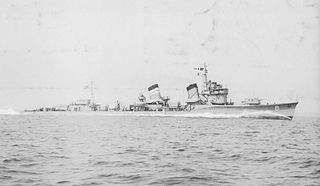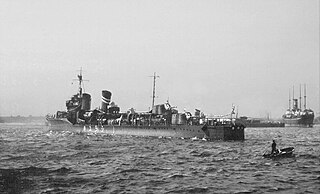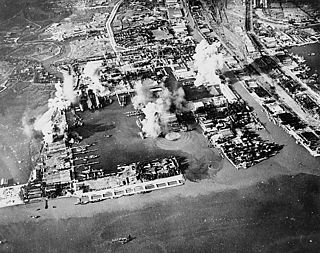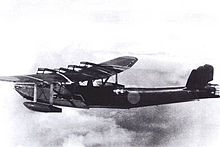
HMS Illustrious was the lead ship of her class of aircraft carriers built for the Royal Navy before World War II. Her first assignment after completion and working up was with the Mediterranean Fleet, in which her aircraft's most notable achievement was sinking one Italian battleship and badly damaging two others during the Battle of Taranto in late 1940. Two months later the carrier was crippled by German dive bombers and was repaired in the United States. After sustaining damage on the voyage home in late 1941 by a collision with her sister ship Formidable, Illustrious was sent to the Indian Ocean in early 1942 to support the invasion of Vichy French Madagascar. After returning home in early 1943, the ship was given a lengthy refit and briefly assigned to the Home Fleet. She was transferred to Force H for the Battle of Salerno in mid-1943 and then rejoined the Eastern Fleet in the Indian Ocean at the beginning of 1944. Her aircraft attacked several targets in the Japanese-occupied Dutch East Indies over the following year before Illustrious was transferred to the newly formed British Pacific Fleet (BPF). The carrier participated in the early stages of the Battle of Okinawa until mechanical defects arising from accumulated battle damage became so severe she was ordered home early for repairs in May 1945.

HMS Indomitable was a modified Illustrious-class aircraft carrier built for the Royal Navy during World War II. Originally planned to be the fourth of the class, she was redesigned to enable her to operate more aircraft, 48 instead of 36. A second hangar was added above the original, raising the flight deck by 14 feet (4.3 m), although the hangar-side armour had to be reduced to compensate. The lower hangar was made shorter than the upper hangar due to the need for extra workshops and accommodation to support the added aircraft.

HMS Formidable was an Illustrious-class aircraft carrier ordered for the Royal Navy before the Second World War. After being completed in late 1940, she was briefly assigned to the Home Fleet before being transferred to the Mediterranean Fleet as a replacement for her crippled sister ship Illustrious. Formidable's aircraft played a key role in the Battle of Cape Matapan in early 1941, and they subsequently provided cover for Allied ships and attacked Axis forces until their carrier was badly damaged by German dive bombers in May.

HMS Warspite was one of five Queen Elizabeth-class battleships built for the Royal Navy during the early 1910s. Completed during the First World War in 1915, she was assigned to the Grand Fleet and participated in the Battle of Jutland. Other than that battle, and the inconclusive Action of 19 August, her service during the war generally consisted of routine patrols and training in the North Sea. During the interwar period the ship was deployed in the Atlantic Ocean and the Mediterranean Sea, often serving as flagship, and was thoroughly modernised in the mid-1930s.

811 Naval Air Squadron was a unit of the British Royal Navy's Fleet Air Arm. It was first founded in 1933, and served during World War II, seeing action in the battle of the Atlantic and on Russian convoys, and was eventually disbanded in 1956.

The Indian Ocean raid, also known as Operation C or Battle of Ceylon in Japanese, was a naval sortie carried out by the Imperial Japanese Navy (IJN) from 31 March to 10 April 1942. Japanese aircraft carriers under Admiral Chūichi Nagumo struck Allied shipping and naval bases around British Ceylon, but failed to locate and destroy the bulk of the British Eastern Fleet. The Eastern Fleet, commanded by Admiral Sir James Somerville, was forewarned by intelligence and sailed from its bases prior to the raid; its attempt to attack the Japanese was frustrated by poor tactical intelligence.

Asagiri was the thirteenth of twenty-four Fubuki-class destroyers, built for the Imperial Japanese Navy following World War I. When introduced into service, these ships were the most powerful destroyers in the world. They served as first-line destroyers through the 1930s, and remained formidable weapons systems well into the Pacific War.

Fubuki was the lead ship of twenty-four Fubuki-class destroyers, built for the Imperial Japanese Navy following World War I. When introduced into service, these ships were the most powerful destroyers in the world. They served as first-line destroyers through the 1930s, and remained formidable weapons systems well into the Pacific War. Fubuki was a veteran of many of the major battles of the first year of the war, and was sunk in Ironbottom Sound during the Battle of Cape Esperance in World War II.

Operation Cockpit was an Allied attack against the Japanese-held island of Sabang on 19 April 1944. It was conducted by aircraft flying from British and American aircraft carriers and targeted Japanese shipping and airfields. A small number of Japanese ships and aircraft were destroyed, and one American aircraft was lost. While the attack was successful tactically, it failed to divert Japanese forces from other areas as had been hoped.

Operation Collar was a small, fast three-ship convoy during the Second World War. The convoy left Britain on 12 November 1940 and passed Gibraltar on 24 November, escorted by two cruisers, two ships for Malta and one bound for Alexandria. Numerous other operations took place partly as diversions and the Italian Fleet sailed to attack British ships, leading to the inconclusive Battle of Cape Spartivento on 27 November. The two merchant ships reached Malta on 26 November.

Hatsuyuki was the third of twenty-four Fubuki-class destroyers built for the Imperial Japanese Navy following World War I. When introduced into service, these ships were the most powerful destroyers in the world. They served as first-line destroyers through the 1930s, and remained formidable weapons systems well into the Pacific War.

Shirayuki was the second of twenty-four Fubuki-class destroyers, built for the Imperial Japanese Navy following World War I. When introduced into service, these ships were the most powerful destroyers in the world. They served as first-line destroyers through the 1930s, and remained formidable weapons systems well into the Pacific War. Shirayuki was sunk in the Battle of the Bismarck Sea on 3 March 1943 while under attack by American and Australian aircraft.

Yūgiri was the fourteenth of twenty-four Fubuki-class destroyers, built for the Imperial Japanese Navy following World War I. When introduced into service, these ships were the most powerful destroyers in the world. They served as first-line destroyers through the 1930s, and remained formidable weapons systems well into the Pacific War.

Operation Transom was an attack by Allied forces against the Japanese-occupied city of Surabaya on the Indonesian island of Java during World War II. Conducted by the British-led Eastern Fleet, the operation took place on 17 May 1944 and involved American and British carrier-based aircraft bombing the city's docks and an oil refinery. An American torpedo bomber was shot down, and two British torpedo bombers were lost in accidents.
818 Naval Air Squadron was a Royal Navy Fleet Air Arm carrier-based squadron formed in August 1939. It served on a number of the Navy's aircraft carriers during the Second World War, serving in most of the theatres of the war, before decommissioning at the end of the war.

The Eastern Fleet, later called the East Indies Fleet, was a fleet of the Royal Navy which existed between 1941 and 1952.

Operation Crimson was an Allied naval operation in the Second World War of the Eastern Fleet, the objective being simultaneous naval bombardment and aircraft attacks on Japanese airfields in the Indonesian cities of Sabang, Lhoknga and Kutaraja, from aircraft carriers in the Indian Ocean on 25 July 1944.

Operation Hurry was the first British operation in a series that have come to be known as Club Runs. The goal of the operation was to fly twelve Hurricane Mk I fighters from HMS Argus to Malta, guided by two Blackburn Skuas. Force H, based in Gibraltar, took the opportunity to raid Elmas airfield in Sardinia and conduct a deception operation with HMS Enterprise. The Mediterranean Fleet conducted diversions in the eastern Mediterranean and the Aegean Sea.

The destroyer HNLMS Tjerk Hiddes was a British built, Dutch warship of World War II. She was laid down on 22 May 1940 as a British N-class destroyer and launched on 25 June 1941 as HMS Nonpareil, but on 27 May 1942, she was transferred to the Royal Dutch Navy. The ship was commissioned in 1942 as HNLMS Tjerk Hiddes, named after the 17th century Dutch admiral, Tjerk Hiddes de Vries. Much of her war service was with the Royal Navy and United States Navy in the Indian Ocean and Australia, under the command of W. J. Kruys. Following the war, the destroyer was sold to Indonesia and renamed RI Gadjah Mada. She was scrapped in 1961.
Force B was the name of several British Royal Navy task forces during the Second World War.





















